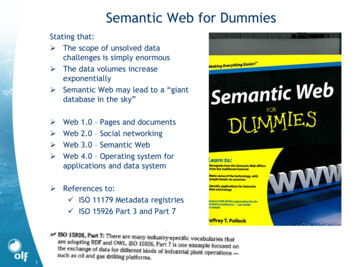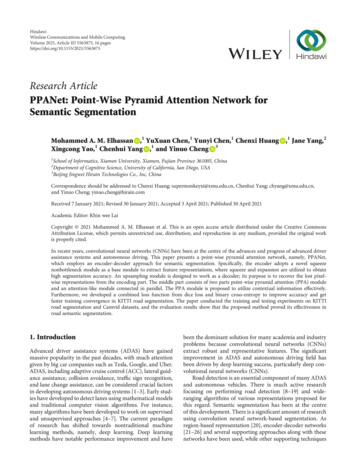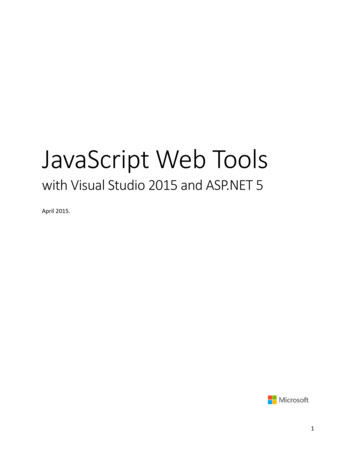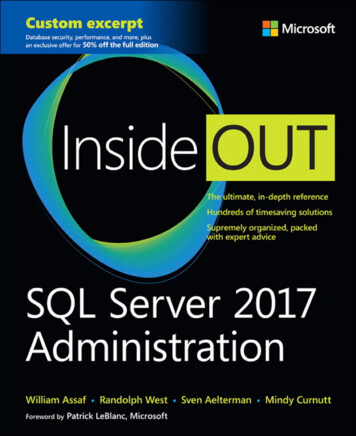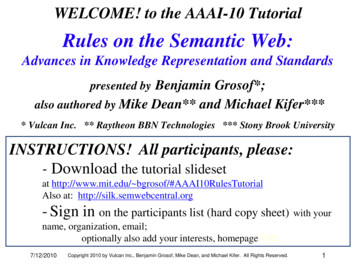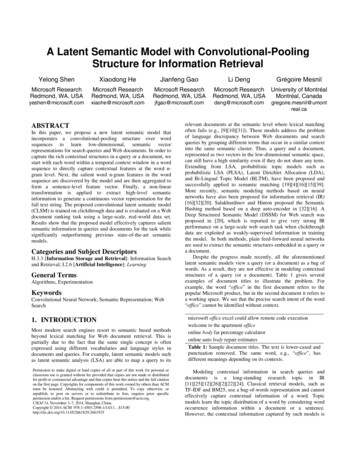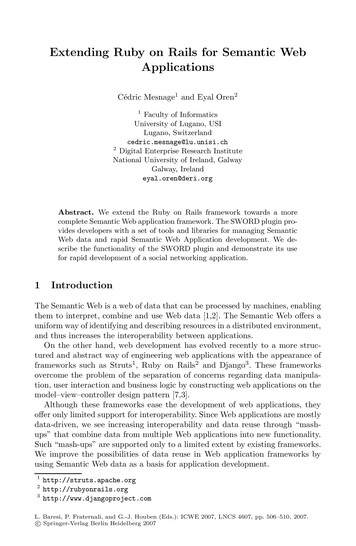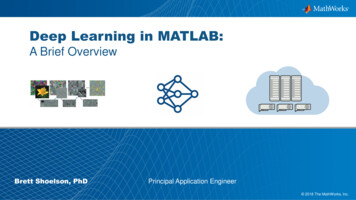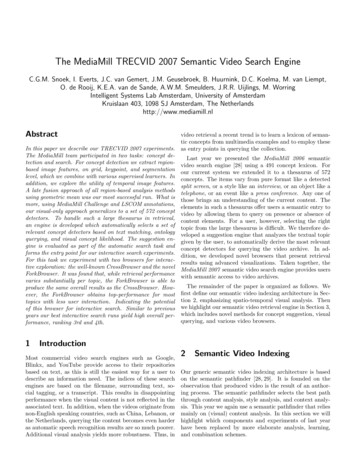
Transcription
The MediaMill TRECVID 2008 Semantic Video Search EngineC.G.M. Snoek, K.E.A. van de Sande, O. de Rooij, B. Huurnink, J.C. van Gemert , J.R.R. Uijlings, J. He,X. Li, I. Everts, V. Nedović, M. van Liempt, R. van Balen, F. Yan† , M.A. Tahir† , K. Mikolajczyk† ,J. Kittler† , M. de Rijke, J.M. Geusebroek, Th. Gevers, M. Worring, A.W.M. Smeulders, D.C. KoelmaISLA, University of AmsterdamAmsterdam, The Netherlands†CVSSP, University of SurreyGuildford, Surrey, UKhttp://www.mediamill.nlAbstractIn this paper we describe our TRECVID 2008 video retrievalexperiments. The MediaMill team participated in threetasks: concept detection, automatic search, and interactive search. Rather than continuing to increase the numberof concept detectors available for retrieval, our TRECVID2008 experiments focus on increasing the robustness of asmall set of detectors using a bag-of-words approach. Tothat end, our concept detection experiments emphasize inparticular the role of visual sampling, the value of color invariant features, the influence of codebook construction, andthe effectiveness of kernel-based learning parameters. Forretrieval, a robust but limited set of concept detectors necessitates the need to rely on as many auxiliary informationchannels as possible. Therefore, our automatic search experiments focus on predicting which information channel totrust given a certain topic, leading to a novel framework forpredictive video retrieval. To improve the video retrieval results further, our interactive search experiments investigatethe roles of visualizing preview results for a certain browsedimension and active learning mechanisms that learn tosolve complex search topics by analysis from user browsing behavior. The 2008 edition of the TRECVID benchmark has been the most successful MediaMill participationto date, resulting in the top ranking for both concept detection and interactive search, and a runner-up ranking forautomatic retrieval. Again a lot has been learned duringthis year’s TRECVID campaign; we highlight the most important lessons at the end of this paper.1Introductionfor a user to describe an information need. The indices ofthese search engines are based on the filename, surroundingtext, social tagging, closed captions, or a speech transcript.This results in disappointing retrieval performance whenthe visual content is not mentioned, or properly reflected inthe associated text. In addition, when the videos originatefrom non-English speaking countries, such as China, or theNetherlands, querying the content becomes much harder asrobust automatic speech recognition results and their accurate machine translations are difficult to achieve.To cater for robust video retrieval, the promising solutionsfrom literature are in majority concept-based [39], where detectors are related to objects, like a telephone, scenes, likea kitchen, and people, like singing. Any one of those bringsan understanding of the current content. The elements insuch a lexicon offer users a semantic entry to video by allowing them to query on presence or absence of visual contentelements. Last year we presented the MediaMill 2007 semantic video search engine [37] using a 572 concept lexicon,albeit with varying performance. Rather than continuing toincrease the lexicon size, our TRECVID 2008 experimentsfocus on increasing the robustness of a small set of conceptdetectors by using a novel approach that builds upon recent findings in computer vision and pattern recognition.A robust but limited set of concept detectors necessitatesthe need to rely on as many information channels as possible for retrieval. To that end, we propose a novel framework for predictive video retrieval that automatically learnsto trust one of three information channels that maximizesvideo search results for a given topic. To improve the retrieval results further, we extend our interactive browsersby supplementing them with visualizations for swift inspection, and active learning mechanisms that learn to solvecomplex search topics by analysis from user browsing behavior. Taken together, the MediaMill 2008 semantic videosearch engine provides users with robust semantic access tovideo archives.Robust video retrieval is highly relevant in a world that isadapting swiftly to visual communication. Online serviceslike YouTube and Truveo show that video is no longer thedomain of broadcast television only. Video has become themedium of choice for many people communicating via InThe remainder of the paper is organizedternet. Most commercial video search engines provide acfirst define our semantic concept detectioncess to video based on text, as this is still the easiest waytion 2. Then we highlight our predictive Currently at: Willow, École Normale Supérieure Paris, France.framework for automatic search in Sectionas follows. Wescheme in Secvideo retrieval3. We present
Figure 2: MediaMill TRECVID 2008 concept detection scheme, using the conventions of Figure 1. The scheme serves as the blueprintfor the organization of Section 2.Figure 3: General scheme for spatio-temporal sampling of image regions, including temporal multi-frame selection, Harris-Laplace anddense point selection, and a spatial pyramid. Detail of Figure 2,using the conventions of Figure 1.sampling strategies, keypoint-based color features [4, 33],codebook representations [8, 10], and kernel-based machinelearning. We detail our generic concept detection schemeFigure 1: Data flow conventions as used in Section 2. Different by presenting a component-wise decomposition. The comarrows indicate difference in data flows.ponents exploit a common architecture, with a standardizedinput-output model, to allow for semantic integration. Thegraphical conventions to describe the system architecturethe innovations of our semantic video search engine in Secare indicated in Figure 1. Based on these conventions wetion 4. We wrap up in Section 5, where we highlight thefollow the video data as they flow through the computamost important lessons learned.tional process, as summarized in the general scheme of ourTRECVID 2008 concept detection approach in Figure 2,and detailed per component next.2Detecting Concepts in VideoWe perceive concept detection in video as a combined computer vision and machine learning problem. Given an ndimensional visual feature vector xi , part of a shot i [27],the aim is to obtain a measure, which indicates whether semantic concept ωj is present in shot i. We may choose fromvarious visual feature extraction methods to obtain xi , andfrom a variety of supervised machine learning approaches tolearn the relation between ωj and xi . The supervised machine learning process is composed of two phases: trainingand testing. In the first phase, the optimal configurationof features is learned from the training data. In the secondphase, the classifier assigns a probability p(ωj xi ) to eachinput feature vector for each semantic concept.Our TRECVID 2008 concept detection approach buildson previous editions of the MediaMill semantic video searchengine [37,38,41]. In addition, we draw inspiration from thebag-of-words approach of Schmid and her associates [24,48],extending their work by putting special emphasis on video2.1Spatio-Temporal SamplingThe visual appearance of a semantic concept in video hasa strong dependency on the spatio-temporal viewpoint under which it is recorded. Salient point methods [45] introduce robustness against viewpoint changes by selectingpoints, which can be recovered under different perspectives.Another solution is to simply use many points, which isachieved by dense sampling. Appearance variations causedby temporal effects are addressed by analyzing video beyondthe key frame level. By taking more frames into accountduring analysis, it becomes possible to recognize conceptsthat are visible during the shot, but not necessarily in a single key frame. We summarize our spatio-temporal samplingapproach in Figure 3.Temporal multi-frame selection We demonstrated in [40]that a concept detection method that considers more video
content obtains higher performance over key frame-basedmethods. We attribute this to the fact that the content ofa shot changes due to object motion, camera motion, andimperfect shot segmentation results. Therefore, we employa multi-frame sampling strategy. To be precise, we samplea maximum of 4 additional frames distributed around the(middle) key frame of each shot.Harris-Laplace point detector In order to determinesalient points, Harris-Laplace relies on a Harris corner detector. By applying it on multiple scales, it is possible toselect the characteristic scale of a local corner using theLaplacian operator [45]. Hence, for each corner the HarrisLaplace detector selects a scale-invariant point if the localimage structure under a Laplacian operator has a stablemaximum.Dense point detector For concepts with many homogenous areas, like scenes, corners are often rare. Hence, forthese concepts relying on a Harris-Laplace detector can besuboptimal. To counter the shortcoming of Harris-Laplace,random and dense sampling strategies have been proposed[6,19]. We employ dense sampling, which samples an imagegrid in a uniform fashion using a fixed pixel interval betweenregions. In our experiments we use an interval distance of6 pixels and sample at multiple scales.Spatial pyramid weighting Both Harris-Laplace and densesampling give an equal weight to all keypoints, irrespectiveof their spatial location in the image frame. In order toovercome this limitation, Lazebnik et al . [20] suggest torepeatedly sample fixed subregions of an image, e.g. 1x1,2x2, 4x4, etc., and to aggregate the different resolutionsinto a so called spatial pyramid, which allows for regionspecific weighting. Since every region is an image in itself,the spatial pyramid can be used in combination with boththe Harris-Laplace point detector and dense point sampling.Reported results using concept detection experiments arenot yet conclusive in the ideal spatial pyramid configuration, some claim 2x2 is sufficient [20], others suggest to include 1x3 also [24]. We use a spatial pyramid of 1x1, 2x2,and 1x3 regions in our experiments.2.2Visual Feature ExtractionIn the previous section, we addressed the dependency of thevisual appearance of semantic concepts in a video on thespatio-temporal viewpoint under which they are recorded.However, the lighting conditions during filming also play animportant role. Burghouts and Geusebroek [4] analyzed theproperties of color features under classes of illumination andviewing changes, such as viewpoint changes, light intensitychanges, light direction changes, and light color changes.Van de Sande et al . [33] analyzed the properties of colorfeatures under classes of illumination changes within thediagonal model of illumination change, and specifically forFigure 4: General scheme of the visual feature extraction methodsused in our TRECVID 2008 experiments.data sets as considered within TRECVID. Another comparison of our invariant visual features, emphasizing discriminatory power, and efficiency of the feature representation ispresented by Van Gemert et al . [10]. Here we summarizetheir main findings. We present an overview of the visualfeatures used in Figure 4.Wiccest Wiccest features [11] utilize natural image statistics to effectively model texture information. Texture isdescribed by the distribution of edges in a certain image.Hence, a histogram of a Gaussian derivative filter is used torepresent the edge statistics. It was shown in [13] that thecomplete range of image statistics in natural textures canbe well modeled with an integrated Weibull distribution,which reduces a histogram to just two Weibull parameters,see [10]. The Wiccest features for an image region consist of the Weibull parameters for the color invariant edgesin the region. Thus, the two Weibull parameters for thex-edges and y-edges of the three color channels yield a 12dimensional feature.Gabor Gabor filters may be used to measure perceptualsurface texture in an image [3]. Specifically, Gabor filtersrespond to regular patterns in a given orientation on a givenscale and frequency, see [10]. In order to obtain an imageregion feature with Gabor filters we follow these three steps:1) parameterize the Gabor filters 2) incorporate color invariance and 3) construct a histogram. First, the parametersof a Gabor filter consist of orientation, scale and frequency.We use four orientations, 0 , 45 , 90 , 135 , and two (scale,frequency) pairs: (2.828, 0.720), (1.414, 2.094). Second,color responses are measured by filtering each color channelwith a Gabor filter. The W color invariant is obtained bynormalizing each Gabor filtered color channel by the intensity. Finally, a histogram of 101 bins is constructed for eachGabor filtered color channel.
SIFT The SIFT feature proposed by Lowe [23] describesthe local shape of a region using edge orientation histograms. The gradient of an image is shift-invariant: takingthe derivative cancels out offsets [33]. Under light intensitychanges, i.e. a scaling of the intensity channel, the gradientdirection and the relative gradient magnitude remain thesame. Because the SIFT feature is normalized, the gradient magnitude changes have no effect on the final feature.To compute SIFT features, we use the version described byLowe [23].OpponentSIFT OpponentSIFT describes all the channelsin the opponent color space using SIFT features. The information in the O3 channel is equal to the intensity information, while the other channels describe the color information in the image. The feature normalization, as effective inSIFT, cancels out any local changes in light intensity.C-SIFT In the opponent color space, the O1 and O2 channels still contain some intensity information. To add invariance to shadow and shading effects, we have proposedthe C-invariant [12] which eliminates the remaining intensity information from these channels. The C-SIFT featureuses the C invariant, which can be intuitively seen as thegradient (or derivative) for the normalized opponent colorspace O1/I and O2/I. The I intensity channel remainsunchanged. C-SIFT is known to be scale-invariant withrespect to light intensity. Due to the local comparison ofcolors, as effective due to the gradient, the color componentof the feature is robust to light color changes. See [4,33] fordetailed evaluation.rgSIFT For rgSIFT, features are added for the r andg chromaticity components of the normalized RGB colormodel, which is already scale-invariant [33]. In additionto the r and g channel, this feature also includes intensity.However, the color part of the feature is not invariant tochanges in illumination color.RGB-SIFT For the RGB-SIFT, the SIFT feature is computed for each RGB channel independently. Due to thenormalizations performed within SIFT, it is equal to transformed color SIFT [33]. The feature is scale-invariant, shiftinvariant, and invariant to light color changes and shift.Figure 5: General scheme for transforming visual features into acodebook, where we distinguish between codebook construction using clustering and codeword assignment using soft and hard variants. We combine various codeword frequency distributions into acodebook library.[8, 10, 19, 21, 33, 35]. First, we assign visual features to discrete codewords predefined in a codebook. Then, we usethe frequency distribution of the codewords as a compactfeature vector representing an image frame. Two important variables in the codebook representation are codebookconstruction and codeword assignment. An extensive comparison of codebook representation variables is presented byVan Gemert et al . in [8, 10]. Here we detail codebook construction using clustering and codeword assignment usinghard and soft variants, following the scheme in Figure 5.Clustering We employ two clustering methods: k-meansand radius-based clustering. K-means partitions the visualfeature space by minimizing the variance between a predefined number of k clusters. The advantage of the k-meansalgorithm is its simplicity. A disadvantage of k-means isits emphasis on clusters of dense areas in feature space.Hence, k-means does not spread clusters evenly throughout feature space. In effect biasing frequently occurring features. To overcome the limitation of k-means clustering,while maintaining efficiency, Jurie and Triggs [19] proposedradius-based clustering. The algorithm assigns visual features to the first cluster lying within a fixed radius of similarity r. Hence, the radius determines whether two visualfeatures describe the same codeword. As an implementation of radius-based clustering we use Astrahans algorithm,see [10]. For both k-means and radius-based clustering wefix the visual codebook to a maximum of 4000 codewords.We compute the Wiccest and Gabor features on denselysampled image regions [10], the SIFT [23] and ColorSIFT[33] features are computed around salient points obtainedHard-assignment Given a codebook of codewords, obfrom the Harris-Laplace detector and dense sampling. Fortained from clustering, the traditional codebook approachall visual features we take several spatial pyramid configudescribes each feature by the single best representative coderations into account.word in the codebook, i.e. hard-assignment. Basically, animage is represented by a histogram of codeword frequencies2.3 Codebook Transformdescribing the probability density over codewords.To avoid using all visual features in an image, while incorporating translation invariance and a robustness to noise, Soft-assignment In a recent paper [8], we show that thewe follow the well known codebook approach, see e.g. traditional codebook approach may be improved by using
soft-assignment through kernel codebooks. A kernel codebook uses a kernel function to smooth the hard-assignmentof image features to codewords. Out of the various forms ofkernel-codebooks, we selected codeword uncertainty basedon its empirical performance [8].Codebook library Each of the possible sampling methodsfrom Section 2.1 coupled with each visual feature extraction method from Section 2.2, a clustering method, andan assignment approach results in a separate visual codebook. An example is a codebook based on dense samplingof rgSIFT features in combination with k-means clustering and hard-assignment. We collect all possible codebook Figure 6: General scheme for kernel-based learning using supportcombinations in a visual codebook library. Naturally, the vector machines and episode-constrained cross-validation for paramcodebooks can be combined using various configurations. eters selection.For simplicity, we employ equal weights in our experimentswhen combining codebooks to form a library.is known to yield a less biased estimate of classifier performance [9].2.4 Kernel-based LearningThe result of the parameter search over q is the improvedLearning robust concept detectors from large-scale visualcodebooks is typically achieved by kernel-based learning model p(ωj xi , q ), contracted to p (ωj xi ), which we use tomethods. From all kernel-based learning approaches on of- fuse and to rank concept detection results.fer, the support vector machine is commonly regarded as asolid choice. We investigate the role of its parameters andhow to select the optimal configuration for a concept, as 2.5 Submitted Concept Detection Resultsdetailed in Figure 6.We investigated the contribution of each component discussed in Sections 2.1–2.4, emphasizing in particular the roleSupport vector machine Similar to previous years, we use of sampling, the value of color invariance, the influence ofthe support vector machine framework [46] for supervised codebook construction, and the effectiveness of kernel-basedlearning of semantic concepts. Here we use the LIBSVM im- learning parameters. In our experimental setup we used theplementation [5] with probabilistic output [22,28]. It is well TRECVID 2007 development set as a training set, and theknown that the parameters of the support vector machine TRECVID 2007 test set as a validation set. The groundalgorithm have a significant influence on concept detection truth used for learning and evaluation are a combination ofperformance [1, 25, 41, 47]. The parameters of the support the common annotation effort [2] and the ground truth provector machine we optimize are C and the kernel function vided by ICT-CAS [44]. The positive examples from bothK(·). In order to handle imbalance in the number of positive efforts were combined using an OR operation and subseversus negative training examples, we fix the weights of the quently verified manually. Based on our extensive experipositive and negative class by estimation from the class pri- ments (data not shown) we arrived at the conclusion thators on training data. While the radial basis kernel function a codebook library employing dense sampling and Harrisusually perform better than other kernels, it was recently Laplace salient points in combination with a spatial pyrashown by Zhang et al . [48] that in a codebook-approach mid, one of the three following (color) SIFT features: SIFT,to concept detection the earth movers distance [32] and χ2 OpponentSIFT, and RGB-SIFT, and a codebook represenkernel are to be preferred. In general, we obtain good pa- tation based on k-means clustering and soft-assignment, isrameter settings for a support vector machine, by using an a powerful baseline for concept detection in video. Thisiterative search on both C and K(·).codebook library, consisting of 6 books in total, is our baseline. The baseline was not submitted for evaluation in theEpisode-constrained cross-validation From all parame- high-level feature extraction task, but post-TRECVID exters q we select the combination that yields the best av- periments indicates it would have obtained a mean infAPerage precision performance, yielding q . We measure of 0.152. Interestingly, the same baseline using only theperformance of all parameter combinations and select the annotations from the common annotation effort [2] yieldedcombination that yields the best performance. We use a similar results [34]. So, on average, the combined annota3-fold cross validation to prevent over-fitting of parame- tions did not help us. The 6-codebook library based on theters. Rather than using regular cross-validation for sup- combined annotations formed the basis of all our TRECVIDport vector machine parameter optimization, we employ an 2008 submissions. An overview of our submitted conceptepisode-constrained cross-validation method, as this method detection runs is depicted in Figure 7, and detailed next.
TRECVID 2008 High level Feature Task Benchmark Comparison1. Classroom2. Bridge194 other systemsMediaMill BabyMediaMill GingerMediaMill PoshMediaMill ScaryMediaMill SportyMediaMill VIDI VideoSemantic Concept3. Emergency/Vehicle4. Dog5. Kitchen6. Airplane Flying7. Two People8. Bus9. Driver10. Cityscape11. Harbor12. Telephone13. Street14. Demonstration/Protest15. Hand16. Mountain17. Nighttime18. Boat/Ship19. Flower20. d Average PrecisionFigure 7: Comparison of MediaMill video concept detection experiments with present-day concept detection approaches in the TRECVID2008 High-level Feature Task benchmark.Baby run The Baby run extends upon the baseline runby also including codebooks for the rgSIFT and C-SIFTfeatures. This results in a codebook library of 10 books.This run achieved a mean infAP of 0.155. Indeed, only asmall improvement over our baseline.Sporty run The codebook library used in the Sporty runextends upon the Baby run by also including the Wiccest and Gabor features, and their early fusion. We apply the standard sequential forward selection feature selection method [18] on this large codebook library. This runachieves the overall highest infAP for the concept Flower,and has a mean infAP of 0.159.VIDI-Video run This run is a cooperation between theUniversity of Amsterdam and the University of Surrey. Ituses multiple kernel learning [43] on the codebook library ofthe Baby run together with another codebook library basedon SIFT only. The weights of the kernels, i.e., the relativeimportance of the 2 codebook libraries, are learnt from thetraining data. It achieved a mean infAP of 0.148.Ginger run The Ginger run extends the codebook libraryof 6 books from the baseline run to the temporal domain.For every shot, up to 5 frames are processed, and the resultsare averaged. This run achieves the overall highest infAPfor the concepts Mountain and Boat/Ship, and has a meaninfAP of 0.185.Posh run The Posh run is based on a codebook libraryin a temporal setting. The codebooks to use per conceptwere chosen on the basis of hold-out performance on thevalidation set. There were 3 sets of codebooks to chosefrom, together with the method for temporal aggregation,which could be either the average or the maximum conceptlikelihood. This run achieves the overall highest infAP forthe concepts Street and Nighttime, and has a mean infAPof 0.184.Scary run The Scary run applies the standard sequential forward selection feature selection method on severalcodebook libraries, all of which have been applied spatiotemporally to up to 5 frames per shot. This run achieved theoverall highest mean infAP in the TRECVID2008 benchmark (0.194), with the overall highest infAP for 4 concepts:Kitchen, Cityscape, Demonstration or protest, and Hand.2.657 Robust Concept DetectorsIn order to have as many concept detectors as possible available for video retrieval, we have employed a graceful degradation approach in previous TRECVID editions [37, 38].This has resulted in lexicons containing close to 600 concept detectors, albeit with mixed performance. In contrastto previous TRECVID editions, we aim for a small but robust lexicon of concept detectors this year. To that end wehave employed our baseline codebook library on the conceptsets of TRECVID 2008 (20 concepts), TRECVID2007 (36concepts) and an additional black/white detector. Comparative experiments with our baseline codebook libraryand last years approach indicates a performance increaseof 100%. Hence, the 2008 MediaMill semantic video searchengine includes 57 robust concept detectors and a powerfulcodebook library for retrieval.
3Automatic Video Retrieval3.1.2Multimodal Fusion and RerankingWe experimented with combining the evidence from multiple retrieval channels using a trust-based framework. Thisis a three-step procedure, as follows. First, given thethree channels, namely, speech, detector, and examplebased search, we select the trusted channel on which there-ranking of the result list will be based. If a named entityis detected, the speech channel is trusted. If an informativedetector directly matches the query, then we trust the detector channel. Otherwise we trust the example-based searchresults. Second, we truncate the trusted result list to thetop 1000 results. The secondary result lists, any shots thatdo not occur in the trusted result list are removed, considering the top 1000 results in the list. Third, we combine the3.1 Predictive Video Retrievalresult lists using rank-based fusion. Any results that areInspired by work in query-difficulty prediction, we predict contained in more than one list will be boosted.which of the three retrieval channels (speech, detector, orexample-based search) should be trusted to provide the best 3.1.3 Retrieval Channel Implementationresults for a given topic. The top search results from thetrusted retrieval channel are used as the basis set of search Our predictive retrieval framework is built on search reresults, and are then reranked with information from the sults from three retrieval channels: speech, detector, andremaining two retrieval channels. By trusting one, and only example-based search. These are implemented as follows:one, information channel, we reduce the need for parameterestimation associated with fusion approaches that consider Speech-based search Our speech based search approachall results from all channels. In addition, the prediction is similar to that of last year, incorporating both the origframework allows for a query-class independent approach inal Dutch automatic speech transcripts donated by thethat we expect will generalize well to include other channels University of Twente [15], and the automatic machineof information.translation provided by Queen Mary, University of LonThe TRECVID automatic search task has, over the previous years, shown that topic type directly relates to thebest type of information for querying. Specifically, namedentity queries can best be answered using speech search.Furthermore, if a robust concept detector is available for aquery, detector-based search should provide reliable results.These principles drive the query-dependent, predictive videoretrieval strategy of the MediaMill 2008 automatic videosearch system.3.1.1Prediction FeaturesWe found, after evaluating topics from previous TRECVIDbenchmarks, that two topic features were especially goodindicators of the best retrieval channel: 1) named entityoccurrence, and 2) exact matches to ‘informative’ detectors.Named entities were extracted from the topics using theStanford Named Entity tagger [7]. Binary occurrence ofnamed entities was used as a feature, so either a topic contained at least one named entity, or it did not.To find exact detector matches, both the detectors andthe topics were linked to WordNet (noun) synsets. If a topicsynset directly matched a detector synset, this was considered a direct match. To determine detector informativeness, the information content was calculated using Resnik’smeasure of information content [29]. If a matched detectorhad an information content higher than 5, it was considered informative. Resnik’s measure is corpus-based, we usea very large Google-based corpus kindly provided to us byHaubold and Natsev [14
complex search topics by analysis from user browsing be-havior. Taken together, the MediaMill 2008 semantic video search engine provides users with robust semantic access to video archives. The remainder of the paper is organized as follows. We first define our semantic concept detection scheme in Sec-tion 2.


